1995 Rugby League World Cup
| 1995 (1995) Rugby League World Cup () | |
|---|---|
 | |
| Number of teams | 10 |
| Host country | |
| Winner | |
| Matches played | 15 |
| Attendance | 265,609 (17,707 per match) |
| Points scored | 718 (47.87 per match) |
| Top scorer | |
| Top try scorer | |
Tournaments < 1989–1992 2000 > | |
The 1995 Rugby League World Cup was held during October in the United Kingdom. It was the eleventh staging of the Rugby League World Cup and was marketed as the Halifax Centenary World Cup, reflecting the tournament's sponsorship and the fact that 1995 marked the 100th birthday of the sport. Envisaged as a celebration of rugby league football,[1] the size of the competition was doubled, with four additional teams invited and Great Britain split into England and Wales (Scotland and Ireland took part in the Emerging Nations Tournament that was held alongside the World Cup.)
The tournament had been preceded by doubts and pessimism; many feared that it would produce one-sided-matches that would be unattractive to supporters. The forthcoming Super League war also hung over the tournament, with the Australian Rugby League refusing to select players who had signed for the rival competition.[2]
In the event, the fears proved unfounded, and the tournament was acclaimed a great success.[3][4] Although many early matches did prove as one-sided as feared, fans still flocked to see newer rugby league nations such as Fiji, Tonga, Western Samoa and South Africa. Large home crowds for the group involving Wales proved particularly encouraging for the sport.
For the 1995 tournament, a £10,000 cup was made by Tiffanys to celebrate the centenary of the game.[5]
The final between Australia and England drew a crowd of 66,540 to Wembley Stadium. Australia won the tournament, their eighth World Cup win and fifth in succession.
Contents
1 Teams
2 Venues
3 Matches
3.1 Group stage
3.1.1 Group A
3.1.2 Group B
3.1.3 Group C
3.2 Knockout stage
3.3 Final
4 Team of the tournament
5 References
6 External links
Teams
Ten teams competed in the Centenary World Cup: Australia, England, Fiji, France, New Zealand, Papua New Guinea, South Africa, Tonga, Wales and Western Samoa.[6] It was the first time since the 1975 World Series that the Great Britain team was split into England and Wales. Fiji, South Africa, Tonga and Western Samoa were all making their World Cup débuts.[7]
A sore point for the tournaments organisers was that Australia was missing a large portion of their best players, a number of whom had been Kangaroo Tourists the previous year, due to the Super League war and the ARL's refusal to select Super League aligned players.[8] Australia's win in the end with what many considered to be a second-string side was seen as a blow to the rebel Super League organisation, with which every other nation was aligned.[9]
In light of the ARL's stance on not selecting players who had signed with Super League, Canberra Raiders players Laurie Daley, Ricky Stuart, Bradley Clyde, Steve Walters and Brett Mullins, won a court order against the ARL making SL players eligible for representative games. However, despite assurances from the ARL that all players were considered, it came as no surprise when only ARL loyal players made the Kangaroos World Cup squad. As one unnamed ARL official allegedly said, the court decision only forced the ARL to consider Super League players, they were not forced select them. As the list of players considered for the squad was never made public by the ARL it remains unknown how many, if any, SL players were actually considered for World Cup selection with rumours persisting that no SL player was actually given any consideration.
Venues
The games were played at various venues in England and Wales.
Wembley Stadium in London was the host stadium for the opening ceremony and match featuring hosts England and defending champions Australia. Wembley, England's national stadium, would also host the Final of the tournament.
Wembley Stadium | Old Trafford | Central Park | Ninian Park |
| Capacity: 82,000 | Capacity: 35,000 | Capacity: 28,000 | Capacity: 21,508 |
 | 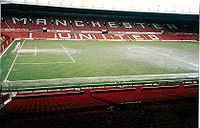 | 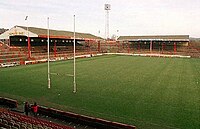 |  |
Alfred McAlpine Stadium | Headingley | Knowsley Road | Gateshead International Stadium |
| Capacity: 20,000 | Capacity: 20,000 | Capacity: 17,500 | Capacity: 11,800 |
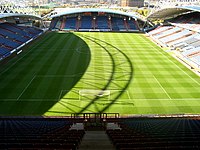 | 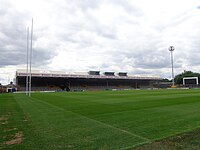 |  | 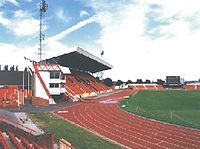 |
Vetch Field | The Boulevard | Wilderspool Stadium | Cougar Park |
| Capacity: 11,500 | Capacity: 10,500 | Capacity: 9,200 | Capacity: 7,800 |
 | 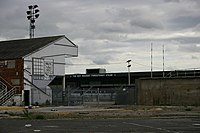 |  |
Matches
Group stage
| Key to colours in group tables |
|---|
| Advances to knockout stage |
Group A
| Team | Played | Won | Drew | Lost | For | Against | Difference | Points |
|---|---|---|---|---|---|---|---|---|
| 3 | 3 | 0 | 0 | 112 | 16 | +96 | 6 | |
| 3 | 2 | 0 | 1 | 168 | 26 | +142 | 4 | |
| 3 | 1 | 0 | 2 | 52 | 118 | −66 | 2 | |
| 3 | 0 | 0 | 3 | 12 | 184 | −172 | 0 |
The tournament opened with a match between hosts England and current World Cup holders Australia at what was a half-full Wembley Stadium (the low crowd of just 41,271 was largely blamed on Australia not playing their Super League stars). It was a grey and showery day and Diana Ross provided pre-match entertainment.[10] Australia were weakened by the absence of any player aligned with Super League, who the ARL refused to select. England were weakened by injuries, most notably that of star winger Martin Offiah.
7 October |
England | 20 – 16 | |
|---|---|---|
Wembley Stadium, London Attendance: 41,271[11] |
England led 10–6 early in the second half, with a try to Andy Farrell late in the first and one to replacement forward Chris Joynt 5 minutes into the second, both coming about through mistakes from Australia's fullback, Tim Brasher.[12] A try to Mark Coyne levelled the score at 10–10. But England's Jason Robinson scored after another Australian handling error by winger John Hopoate with twelve minutes remaining. Another England try, this time from an interception by Paul Newlove put the result beyond doubt. This game attracted 4.2 million viewers.[4]
8 October |
Fiji | 52 – 6 | |
|---|---|---|
Cougar Park, Keighley Attendance: 4,845 |
As expected, rugby league minnows South Africa were the easybeats of Group A, but the Rhinos won plenty of fans with their never say die attitude despite being clearly outclassed by their opposition.
10 October |
Australia | 86 – 6 | |
|---|---|---|
Gateshead International Stadium, Gateshead Attendance: 9,181 |
11 October |
England | 46 – 0 | |
|---|---|---|
Central Park, Wigan Attendance: 26,263 Referee: Dennis Hale |
14 October |
Australia | 66 – 0[13] | |
|---|---|---|
McAlpine Stadium, Huddersfield Attendance: 7,127 Referee: Eddie Ward |
14 October |
England | 46 – 0 | |
|---|---|---|
Headingley Rugby Stadium, Leeds Attendance: 14,041 |
Group B
| Team | Played | Won | Drew | Lost | For | Against | Difference | Points |
|---|---|---|---|---|---|---|---|---|
| 2 | 2 | 0 | 0 | 47 | 30 | +17 | 4 | |
| 2 | 0 | 1 | 1 | 52 | 53 | −1 | 1 | |
| 2 | 0 | 1 | 1 | 34 | 50 | −16 | 1 |
Tonga proved to be the surprise packets of Group B while New Zealand, although winning the group, were a disappointment. Tonga actually led the Kiwis 24−12 late in their pool game at Warrington, but two late tries and a Matthew Ridge field goal prevented one of the biggest boil overs in World Cup history.
8 October |
New Zealand | 25 – 24 | |
|---|---|---|
Wilderspool Stadium, Warrington Attendance: 8,083 |
10 October |
Papua New Guinea | 28 – 28 | |
|---|---|---|
The Boulevard, Hull Attendance: 5,121 |
13 October |
New Zealand | 22 – 6 | |
|---|---|---|
Knowsley Road, St Helens Attendance: 8,679 |
Group C
| Team | Played | Won | Drew | Lost | For | Against | Difference | Points |
|---|---|---|---|---|---|---|---|---|
| 2 | 2 | 0 | 0 | 50 | 16 | +34 | 4 | |
| 2 | 1 | 0 | 1 | 66 | 32 | +34 | 2 | |
| 2 | 0 | 0 | 2 | 16 | 84 | −68 | 0 |
As expected Wales, led by their inspirational dual-rugby international captain Jonathan Davies in his last appearance before retiring from international league, easily won Group C. The French however, twice a former World Cup Finalist in 1954 and 1968, were largely disappointing and did not win a match. The Graham Lowe coached Western Samoans, featuring a number of former New Zealand test players, entertained the Welsh fans with their bruising and enterprising style of play.
9 October |
Wales | 28 – 6 | |
|---|---|---|
Ninian Park, Cardiff Attendance: 10,250 |
12 October |
France | 10 – 56 | |
|---|---|---|
Ninian Park, Cardiff Attendance: 2,173 |
15 October |
Wales | 22 – 10 | |
|---|---|---|
Vetch Field, Swansea Attendance: 15,385 |
This match featured eight former and future Welsh rugby union internationals and two former All Blacks.
Knockout stage
England as expected defeated reigning European Champions Wales in their Semi-final at Old Trafford. The other Semi at Huddersfield almost produced a boil over. After defeating New Zealand 3–0 in the Trans-Tasman Test series earlier in the year, and with the Kiwis lackluster form in their Group B games, Australia was expected to easily account for Frank Endacott's side, but the Kiwis found form and the game ended 20–all at the end of 80 minutes. However, 20 minutes of extra time saw Australia skip away to a 30–20 win to book their place in the Final at Wembley.
| Semi-finals | Final | |||||
| 21 October – Old Trafford, Manchester Attendance: 30,042 Man of the Match: Bobbie Goulding | ||||||
25 | ||||||
| 28 October – Wembley Stadium, London[14] Attendance: 66,540[15] | ||||||
| 10 | ||||||
| 8 | ||||||
| 22 October – McAlpine Stadium, Huddersfield Attendance: 16,608 | ||||||
16 | ||||||
30 | ||||||
| 20 | ||||||
Final
The Australians had reached the final after a hard-fought 30–20 Semi-final win over New Zealand at the McAlpine Stadium which had gone into extra time after the score was locked at 20-all after 80 minutes. Their opponents and tournament host England, had an easier time defeating Wales 25–10 in their Semi at Old Trafford.[16] Even though they were favoured to win, Australia went into the final having lost three of their past four games at Wembley (the only win being the World Cup final of 1992), and had already lost the opening match of the tournament there to the English. Also, due to the ARL's policy of not selecting Super League aligned players, the Kangaroos went into the game with 11 of their 17 players under the age of 24. Although considered mostly a 'second string' team without the likes of Laurie Daley, Ricky Stuart, Andrew Ettingshausen, Steve Renouf, Steve Walters and Glenn Lazarus, most of the Kangaroos had played in the 3–0 whitewash of New Zealand in the Trans-Tasman series earlier in the year.[17] Kangaroos captain and five-eighth Brad Fittler and fullback Tim Brasher were the only members of Australia's 1992 World Cup Final win over Great Britain at Wembley,[9] with both players in the same positions as they had been three years previously.
England's captain Shaun Edwards ruled himself out of the final with an infected knee.[18] Despite almost being ruled out of the tournament with pneumonia, St Helens centre Paul Newlove was selected by coach Phil Larder for starting line-up in the final. Larder also handed the captaincy to veteran test forward Denis Betts. With the former Wigan back rower now playing for the Auckland Warriors in the Australian premiership, his selection as captain created history as he became the first player to captain England while not currently playing in the British competition.[19]
After winning in 1992, Australian coach Bob Fulton became just the second coach (after Harry Bath) to win two Rugby League World Cup's. It was Fulton's 5th World Cup win after also winning in 1968, 1970 and 1975 as a player. Coincidentally, Fulton's coach in the 1968 and 1970 World Cup Finals was Harry Bath.
Status Quo performed the pre-match entertainment.
28 October 1995 14:30 |
England | 8 – 16 | |
|---|---|---|
Tries: Paul Newlove Goals: Bobby Goulding (2/3) | [20] | Tries: Rod Wishart Tim Brasher Goals: Andrew Johns (4/6) |
Wembley Stadium, London Attendance: 66,540 Referee: Stuart Cummings Man of the Match: Andrew Johns |
England | Australia |
|
| ||||||||||||||||||||||||||||||||||||||||||||||||||||||||||||||||||||||||||||||||||||||||||||||||||||||||||||||||||||||||||||||
First-half
England won the coin toss and Australia's Andrew Johns kicked off the match. In England's first set with the ball Australia were penalised for their skipper Brad Fittler's high tackle on Andrew Farrell. From the resulting good field position England were able to force a line drop-out and get another set of six in Australia's half of the field. At the end of the set, Radlinski put up a high kick, which Australia's fullback Tim Brasher failed to secure and Australia were penalised for regathering the ball when off-side. Bobbie Goulding kicked the penalty goal from fifteen metres out, giving his side a 2 – 0 lead.[21] From Australia's resulting kick-off, the English players couldn't secure the ball and it was regathered by the Kangaroos deep in the opposition half. On the last tackle of the ensuing set, Johns at first receiver put a chip kick into the left-hand corner of England's in-goal area where winger Rod Wishart dived in and got a hand on it,[22] giving Australia the first try of the match in the seventh minute.[23] Johns then converted the try from the touch-line and the Kangaroos were leading 2 – 6.[24] A few minutes later England were penalised around the centre of the field and Johns attempted the kick at goal but missed. With the game now swinging from end to end, Johns conceded a penalty close to the goal posts and Goulding's kick bounced off the uprights but went in,[21] so England were trailing 4 – 6 by the eighteenth minute. A few minutes later England conceded a penalty in front of their goal posts and Johns kicked Australia to a 4 – 8 lead. Shortly after that England winger Martin Offiah made a break down along the left sideline and was contentiously ruled to have been taken over the sideline by a desperate Tim Brasher tackle as he threw the ball back into the field for Paul Newlove to toe ahead and dive on, though television replays suggested that Offiah had managed to release the ball before he went into touch.[16] After a high shot from Andy Farrell on Mark Carroll, Johns kicked another penalty giving Australia a 4 – 10 lead at the thirty-minute mark. Just before the half-time break England conceded another penalty in the ruck but Johns' kick missed so the score remained unchanged at the break.[25]
Second half
After making their way into good attacking field position, England played the ball ten metres out from Australia's goal-line where centre Paul Newlove at dummy-half ran the ball at the defence forced his way through to score in the left corner.[26] The sideline conversion attempt by Goulding missed so England trailed 8 – 10 after five minutes of the second half.[16] Around the ten-minute mark the game was interrupted by a topless female streaker.[27] The play continued swinging from one end of the field to the other, with neither team able to capitalise on their scoring opportunities for the next twenty minutes. Australian interchange player Jason Smith was blood binned and had to return to the bench. A few minutes later the Kangaroos had made their way deep into England's half when, on the last tackle, the ball was moved through the hands and eventually flicked passed back from Johns as he was being tackled to the feet of Brasher who kicked it ahead to the try-line.[26] Both fullbacks then scrambled to get to the ball and the referee ruled that Brasher had grounded it, awarding Australia a try.[16] Johns converted the try so Australia lead 8 – 16 with just over ten minutes remaining. England forward Karl Harrison then had to come off the field with an injured arm. A few minutes from full-time Australian forward Mark Carroll was sent to the sin-bin for an infringement in the ruck. The remainder of the match extended into additional injury time but was played with no further points so Australia retained the World Cup with an 8 – 16 victory and their fifth consecutive world title.
21-year-old Andrew Johns was named man-of-the-match.[28] Kangaroos coach Bob Fulton had named the young half as the team hooker, and he did indeed pack into the scrums. However Johns played at halfback in general play with Geoff Toovey having the dummy-half duties, necessary because Toovey had actually injured his neck during the tournament and simply could not pack into the front row in the scrums.[7]
Following the match Prince Edward, Earl of Wessex presented Kangaroos captain Brad Fittler with the Cup and each of the players with medals.[9][25] During the 1990 Kangaroo Tour, an 18-year-old Fittler had reportedly broken protocol when he had said "G'day dude" to Prince Edward's father, HRH Prince Philip, Duke of Edinburgh when the team had met the Duke as part of the tour. History allegedly repeated itself as Fittler was heard to say "Thanks dude" to Prince Edward when receiving the World Cup on the Wembley balcony.
Team of the tournament
The following players were selected as the 1995 World Cup "Team of the Tournament"[citation needed]
|
|
References
^ Menzies, Steve; Tasker, Norman (2008). Beaver: The Steve Menzies Story. Australia: Allen & Unwin. p. 95. ISBN 978-1-74175-560-2..mw-parser-output cite.citation{font-style:inherit}.mw-parser-output q{quotes:"""""""'""'"}.mw-parser-output code.cs1-code{color:inherit;background:inherit;border:inherit;padding:inherit}.mw-parser-output .cs1-lock-free a{background:url("//upload.wikimedia.org/wikipedia/commons/thumb/6/65/Lock-green.svg/9px-Lock-green.svg.png")no-repeat;background-position:right .1em center}.mw-parser-output .cs1-lock-limited a,.mw-parser-output .cs1-lock-registration a{background:url("//upload.wikimedia.org/wikipedia/commons/thumb/d/d6/Lock-gray-alt-2.svg/9px-Lock-gray-alt-2.svg.png")no-repeat;background-position:right .1em center}.mw-parser-output .cs1-lock-subscription a{background:url("//upload.wikimedia.org/wikipedia/commons/thumb/a/aa/Lock-red-alt-2.svg/9px-Lock-red-alt-2.svg.png")no-repeat;background-position:right .1em center}.mw-parser-output .cs1-subscription,.mw-parser-output .cs1-registration{color:#555}.mw-parser-output .cs1-subscription span,.mw-parser-output .cs1-registration span{border-bottom:1px dotted;cursor:help}.mw-parser-output .cs1-hidden-error{display:none;font-size:100%}.mw-parser-output .cs1-visible-error{font-size:100%}.mw-parser-output .cs1-subscription,.mw-parser-output .cs1-registration,.mw-parser-output .cs1-format{font-size:95%}.mw-parser-output .cs1-kern-left,.mw-parser-output .cs1-kern-wl-left{padding-left:0.2em}.mw-parser-output .cs1-kern-right,.mw-parser-output .cs1-kern-wl-right{padding-right:0.2em}
^ Hadfield, Dave (1 October 1995). "Celebration a slow burn". The Independent. London: independent.co.uk. Retrieved 6 October 2009.
^ "1995 Rugby League World Cup". gillette4nations.co.uk. Rugby League International Federation. Retrieved 4 January 2014.
^ ab Masters, Roy (30 October 1995). "Cup recipe is a big winner". The Sydney Morning Herald. Retrieved 4 January 2014.
^ "A history of the Rugby League World Cup". St Helens Star. 1 October 2013. Retrieved 4 January 2014.
^ Hadfield, Dave (6 October 1995). "Team-by-team guide to Centenary Celebrations". The Independent. London: independent.co.uk. Retrieved 6 October 2009.
^ ab "History of the Rugby League World Cup". skysports.com. 16 October 2013. Retrieved 4 January 2014.
^ Richard, de la Riviere. "The Golden Boot: The Missing Years – 1995". totalrl.com. League Publications. Retrieved 4 January 2014.
^ abc "Kangaroos' win blow to rebel league". The Age. 30 October 1995. Retrieved 4 January 2014.
^ Grace Jones and FIFA, Diana Ross at USA 94 and six of the best unlikely entertainers at sport
^ Wilson, Andy (4 November 2011). "Wembley Rugby League internationals – in pictures". guardian.co.uk. Retrieved 27 December 2011.
^ Thomsen, Ian (9 October 1995). "The Cream Is Curdled in Rugby's Other Cup". The New York Times. The New York Times Company. Retrieved 4 December 2009.
^ Hadfield, Dave (15 October 1995). "Rugby League World Cup: Flying Fittler floors Fiji". The Independent. London. Retrieved 20 April 2010.
^ Paddy McAteer (22 December 2010) "Whole World in their Hands" Archived 5 October 2012 at the Wayback Machine. North West Evening Mail
^ Johnson, Martin (30 October 1995). "Nothing focuses an Aussie sportsman more than stuffing the Poms". The Independent. UK: independent.co.uk. Retrieved 28 November 2010.
^ abcd Thomsen, Ian (30 October 1995). "Australians Retain Rugby League Title". The New York Times. Retrieved 4 January 2014.
^ Ian, Thomsen (28 October 1995). "Australia Faces England at Wembley : A Final of Rugby Favorites". The New York Times. nytimes.com. Retrieved 5 November 2009.
^ "A fear of failure spurs Australia". The Age. 27 October 1995. Retrieved 4 January 2014.
^ Hadfield, Dave (28 October 1995). "Connolly returns as England gamble". The Independent. Retrieved 8 January 2014.
^ 1995 World Cup Final
^ ab Corrigan, Peter (29 October 1995). "Australia deliver the magic". The Independent. Retrieved 8 January 2014.
^ Richard, de la Riviere. "28th October: Aussies win Centenary World Cup". totalrl.com. League Publications. Retrieved 8 January 2014.
^ "On this day". espn.co.uk. ESPN Sports Media. Retrieved 8 January 2014.
^ Johns, Matthew (11 April 2007). "Matthew Johns on his brother". The Daily Telegraph. Retrieved 8 January 2014.
^ ab Robinson, Jason (2012). Finding My Feet. UK: Hachette.
^ ab Masters, Roy (30 October 1995). "Roos on top of the world". The Sydney Morning Herald. Retrieved 4 January 2014.
^ "Pitch invaders!" (PDF). psillakis.com. Retrieved 4 January 2014.
^ theguardian.com. "The Joy of Six: Rugby League World Cup moments". The Guardian. Guardian News and Media. Retrieved 5 January 2014.
External links
- 1995 World Cup audio highlights
- 1995 World Cup Final at rlphotos.com
- 1995 World Cup data at hunterlink.net.au
- 1995 World Cup at rlif.com
- 1995 World Cup at rlhalloffame.org.uk
- 1995 World Cup at rugbyleagueproject.com
- 1995 World Cup at 188-rugby-league.co.uk